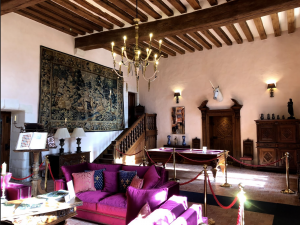Living room furniture
Furniture and sculptures during the Renaissance period were influenced by Gothic elements (still close in the
past) and decorative elements from the Italian Renaissance. Seats were organized according to a hierarchy,
with various forms such as benches, stools, folding chairs, and armchairs. Ornamental motifs included
arabesques, grotesques, and symbolic floral compositions.
In the Grand Salon Charles VIII, the French-style ceiling dating back to 1519 is remarkable. The beams are
made of wood from the Amboise forest, as revealed by dendrochronology.
Renaissance fireplaces were adorned with elegant sculptures and paintings. The uprights and mantels were
richly decorated, and the mantel’s keystone bore the coat of arms of Château Gaillard. The fireplaces allowed
a person to stand by for warmth. A solid wrought iron andiron, adorned with a heart and a fleur-de-lis,
adorned the hearth.
The Blois faience from 1840, produced by the Ulysse de Blois Manufacture, were remarkable ceramic pieces.
titre
16th Century
This chest is one of the ten wedding chests that were given to François I during his marriage to Claude de
France. This carved chest represents François I on the left side and Claude de France on the right side. The
wedding chest was intended to decorate the bridal chamber. This storage chest was an essential part of furniture
until the late 16th century before gradually being replaced by the chest of drawers. Renaissance kings, still being
itinerant, traveled with their furniture and often suffered the consequences. Renaissance furniture is, therefore,
rare and precious.
During the Renaissance, from the 14th to the 16th century, elaborately decorated wooden wedding chests, called
« cassoni » (singular « cassone »), were an integral part of marriage rituals in Italy. Ordered in pairs and shaped
like ancient sarcophagi, they were carried in procession from the bride’s house to her husband’s after the
wedding. Throughout the marriage, the chests continued to serve as storage and seating and were among the
most prestigious pieces of furniture in the house
The history of billiards begins with Louis XI, the father of Charles VIII. Suffering from back problems, he reportedly
ordered his woodturner to make a table for playing croquet at waist height. The earliest billiards were simply a table with
a cloth on it, and the colored balls were pushed using sticks with curved ends. Billiards continued to evolve, and Louis
XIII proclaimed the end of the transitional period, standing on a billiard table. The ancestor of modern billiards dates
back to the 17th century. According to some engravings, including one from 1674 (depicting a billiard table with 6
pockets, 2 balls, and a croquet hoop), it was played on tables with pockets and only 2 balls, a hoop called a « port, » and a
pin called the « king. » Engravings depict Louis XIV playing billiards, a game then reserved for the nobility.

